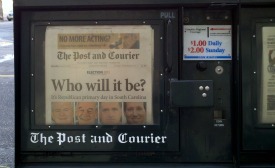One of the main media frames for the 2012 presidential campaign is the way in which media frames are changing. And they are, too—but not all of them.
Plenty of stories have been written—including here at CJR—about how the GOP’s “national primary” has reduced competition for attention from the early-state press. Meanwhile, the endless string of debates produces steady fodder for wall-to-wall cable coverage, and even legacy media institutions are trying their hand at political media start-ups. The proliferation of sources means that avid consumers of political news can select news that’s attuned to their worldviews. And the unceasing coverage means, as The New Yorker’s Ryan Lizza told Howard Kurtz, that “everyone”—or at least, everyone who cares—knows “exactly what the political conversation is among the insiders.”
In short, the political news landscape is expanding, becoming more immediate, and becoming more customizable. So I was struck, when speaking with voters in the run-up to last week’s GOP primary in South Carolina, how many said they turned for information about the candidates to the most old-school and embattled of media outlets: the local newspaper.

Take for example Sandy Griffin, whom I met at a Mitt Romney rally in North Charleston. Griffin said she sometimes watches Fox News and will occasionally read The New York Times on her Nook. But she told me she finds most useful, and reads daily, the straightforward politics coverage of The Post and Courier, Charleston’s local paper.
Griffin explained that she disliked the tendency of the national media to prioritize issues such as Romney’s vast wealth and then-undisclosed tax returns (“I don’t really care. He says he’ll bring it out by April.”) or Newt Gingrich’s infidelity (“It’s fine if they report it, but the first question of a debate?—that’s morality, not politics.”)
By contrast, Griffin said, The Post and Courier offered her information about the competing platforms. “They reported each candidate’s philosophy and history.” (She added that she has not missed a debate, and she tuned into them for the same reason—to get a sense of the candidates’ positions.)
A GOP primary voter named Caroline (she did not want to give her last name), whom I met as she left a polling place in downtown Charleston, said she got her campaign news from CNN, local television, and The Post and Courier. She shared Griffin’s preference for her local paper’s simple but substantive “meet the candidates” coverage—“It took each of the issues and said where each candidate stood,” she explained.
Meanwhile, a televised debate a few days before the vote had nearly swayed her vote for another reason: “CNN was very unfair to Ron Paul. I was so disgusted I almost voted for him just because of the unfairness.”
In fact, of the roughly two dozen South Carolina voters I spoke to about their political news preferences, only a few did not cite their local papers—The Post and Courier in Charleston and The State in Columbia—as a regular source. (The outliers were all activist types, which squares with research findings that the most politically engaged partisans are more likely to choose ideologically friendly coverage.) The local papers were also the only outlet whose reporting was generally perceived as being without ideological bias. Like Griffin and Caroline, the voters I spoke with appreciated the basic this-is what-this-candidate-believes-in approach to campaign coverage that the papers offered. And while much of this nuts-and-bolts reporting on the candidates’ platforms came from wire services, both The State and The Post and Courier had plenty of original reporting at campaign events in the area.
The lesson in these anecdata isn’t that the media should shrink from an active role in identifying and pursuing important stories. When there’s a story that merits scrutiny, national (and local) press should jump on it, even when that means aggravating voters who have been primed to resent the “elite media.” Meanwhile, as the circle of insiders expands, it makes sense that more media outlets will compete for a share of the “politics junkie” audience.
But it’s worth remembering that one of the first things voters need to know (and want to know) about the campaign is simply where the candidates stand—and that, even in a fragmented media landscape overrun with never-before-seen quantities of “paid media,” many readers still turn to trusted local sources for that information. Political reporters should aspire to do more than the basics, and to bring scrutiny and skepticism to bear on the messages coming out of the campaigns. But that process begins with helping voters learn what those messages are.
Erika Fry is a former assistant editor at CJR.
